Tom's Hardware Verdict
The Fractal Design Ion+ Platinum 760 offers good performance, silent operation, and an easy installation, thanks to its highly flexible modular cables.
Pros
- +
Full power at 47 degrees Celsius
- +
Good performance
- +
Silent
- +
Fully modular
- +
Ultra-flexible cables
- +
FDB fan
- +
2x & 6x PCIe connectors
- +
10-year warranty
Cons
- -
OCP is set high on all rails
- -
Very low efficiency with 2% load
- -
Not efficient 5VSB rail
- -
Increased vampire power consumption
- -
Small distance between the peripheral connectors
Why you can trust Tom's Hardware
The competition to get into PC's is tough in the 750-850W range; as you can see clearly in our best power supplies ranking, Seasonic and Corsair dominate. Fractal Design tries to fight back, though, with the Ion+ Platinum 760W, which achieves good performance and keeps its noise output levels low. The cherry on top is the modular cables, which are highly flexible. Fractal Design managed to keep the price down, and still offer a warranty period as high as competitors like Corsair's RM750x and Seasonic's Focus Plus Platinum 750.
We have already evaluated three members of the Ion+ line, the 560P, 660P and 860P, so it was high time to take a look at the second strongest member of the series, the 760P. All Ion+ units use a High Power platform that has good build quality and offers performance levels that meet the competition. The main advantages of the Ion+ 760P, besides its high-efficiency levels (80 Plus Platinum and Cybenetics ETA-A), are the quality FDB fan, the flexible modular cables and the electrolytic caps that High Power used, which are provided by Japanese manufacturers.

Product Photos
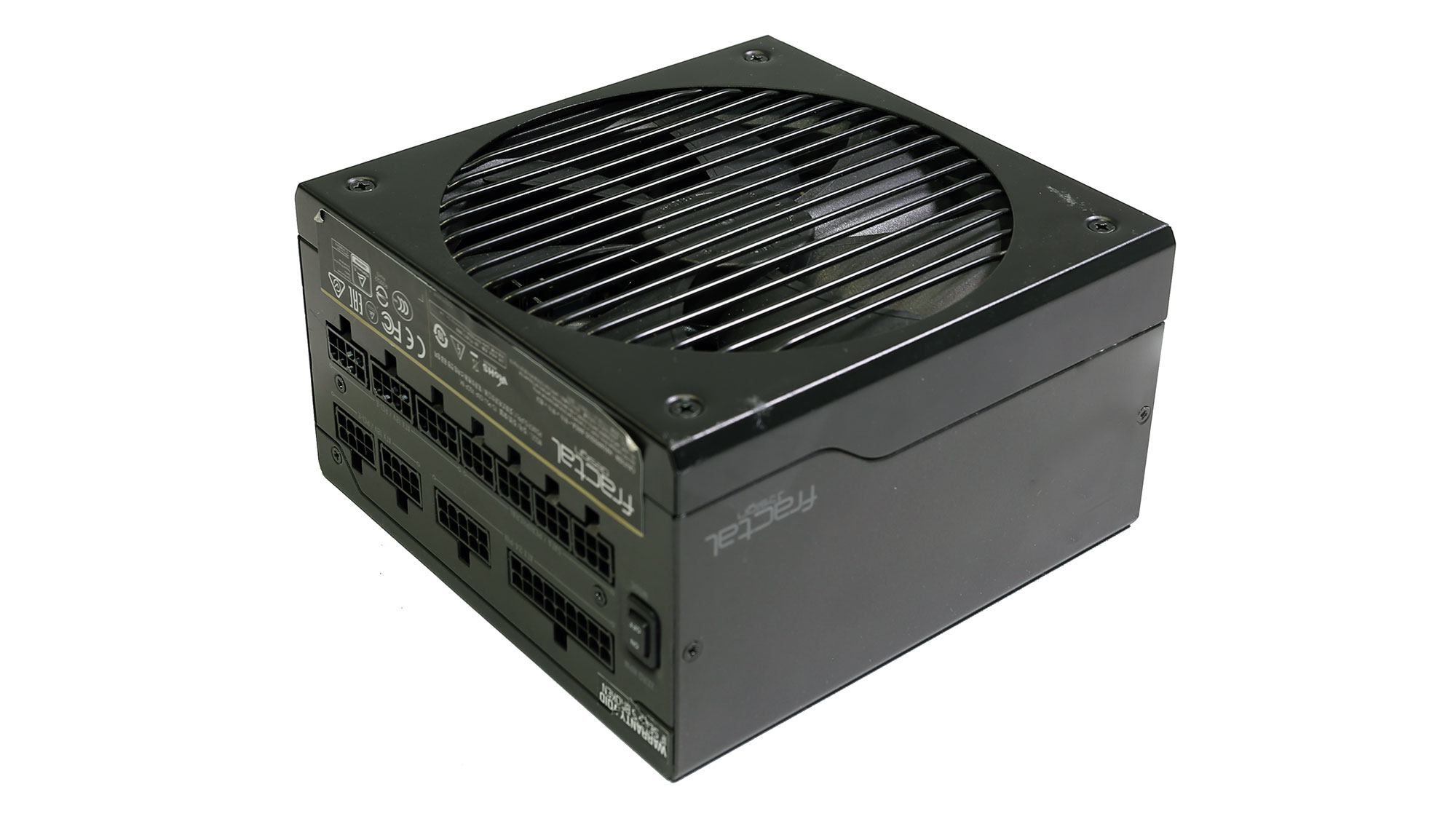





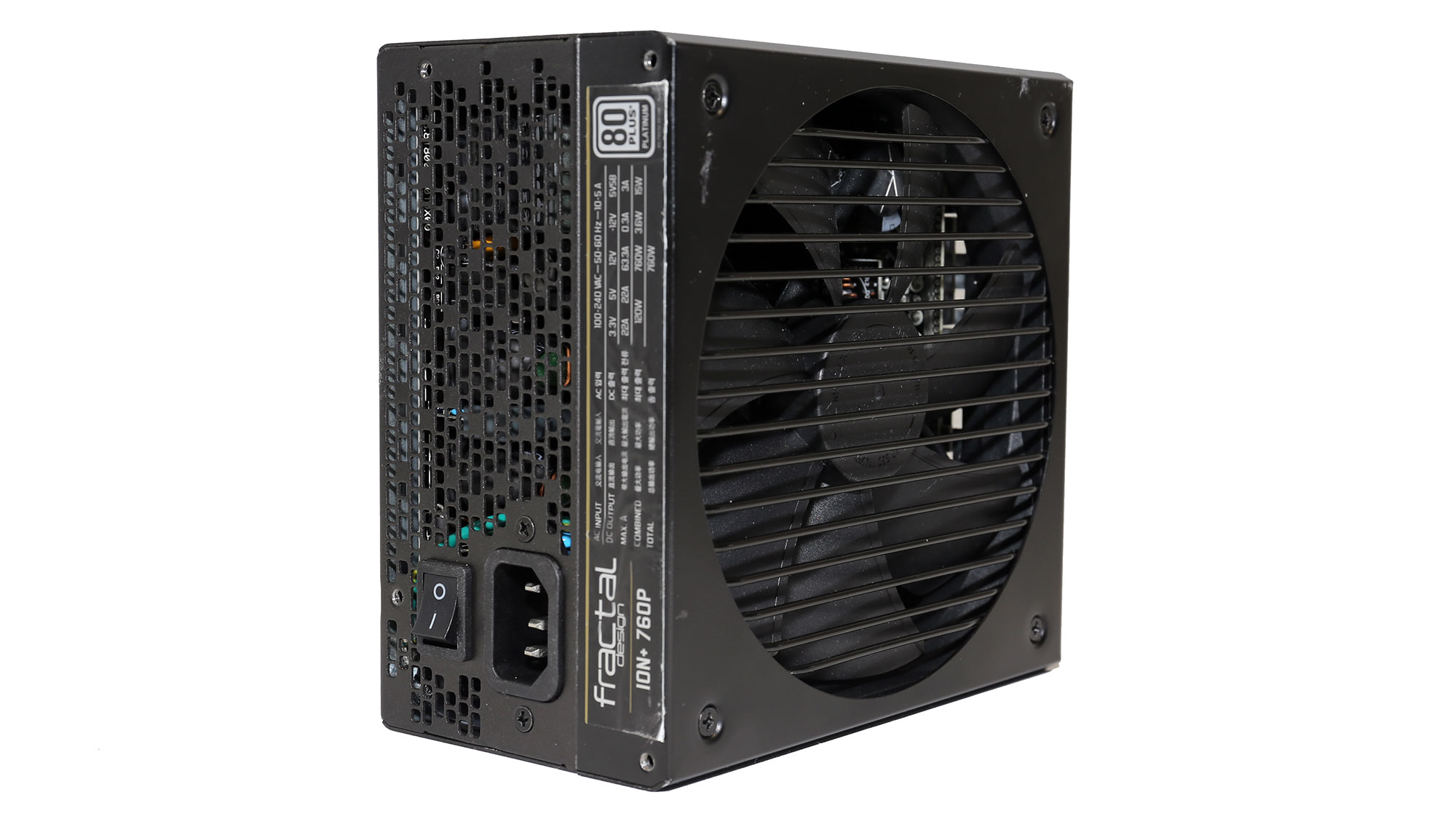


The Ion+ 760P has both the capacity and the required EPS connectors to support high-end mainboards for both Intel and AMD processors. With the release of the AMD X570 mainboards, the era of the single EPS PSUs is long gone, as the majority of these boards require one EPS (8-pin) and one ATX12V (4-pin) while the high-end boards need a pair of EPS connectors. We were complaining for quite some time now when we found a mid-capacity PSU with a single EPS connector, and most brands and manufacturers were saying that more would be overkill. At the same time, four PCIe connectors look normal even in 550W and 650W PSUs, even though most users don't install more than one GPU in their systems. Well, the times have changed, and it is highly preferable to have double EPS connectors instead of more than two PCIe connectors in the 550W-650W range.

Product Photos
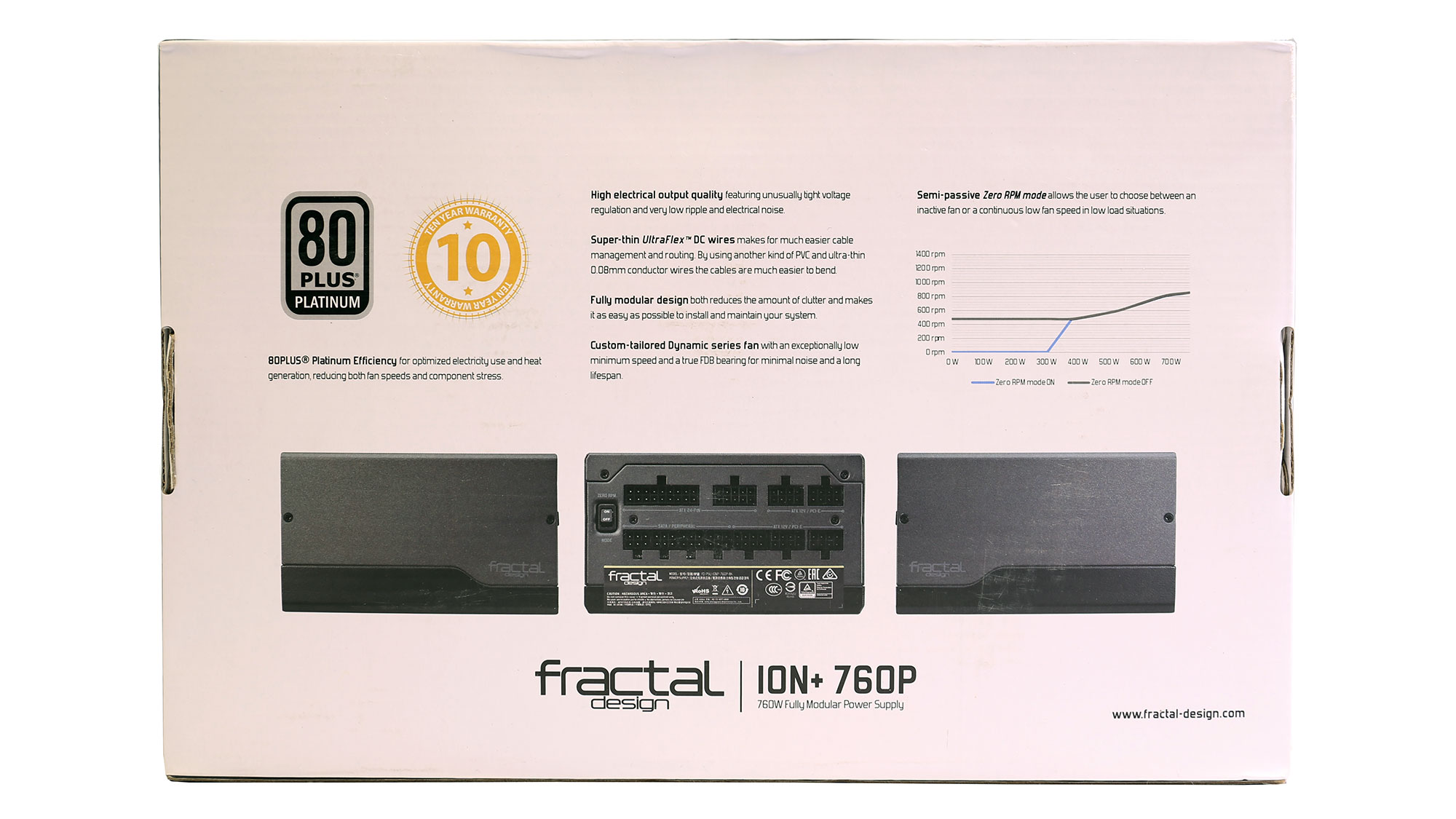

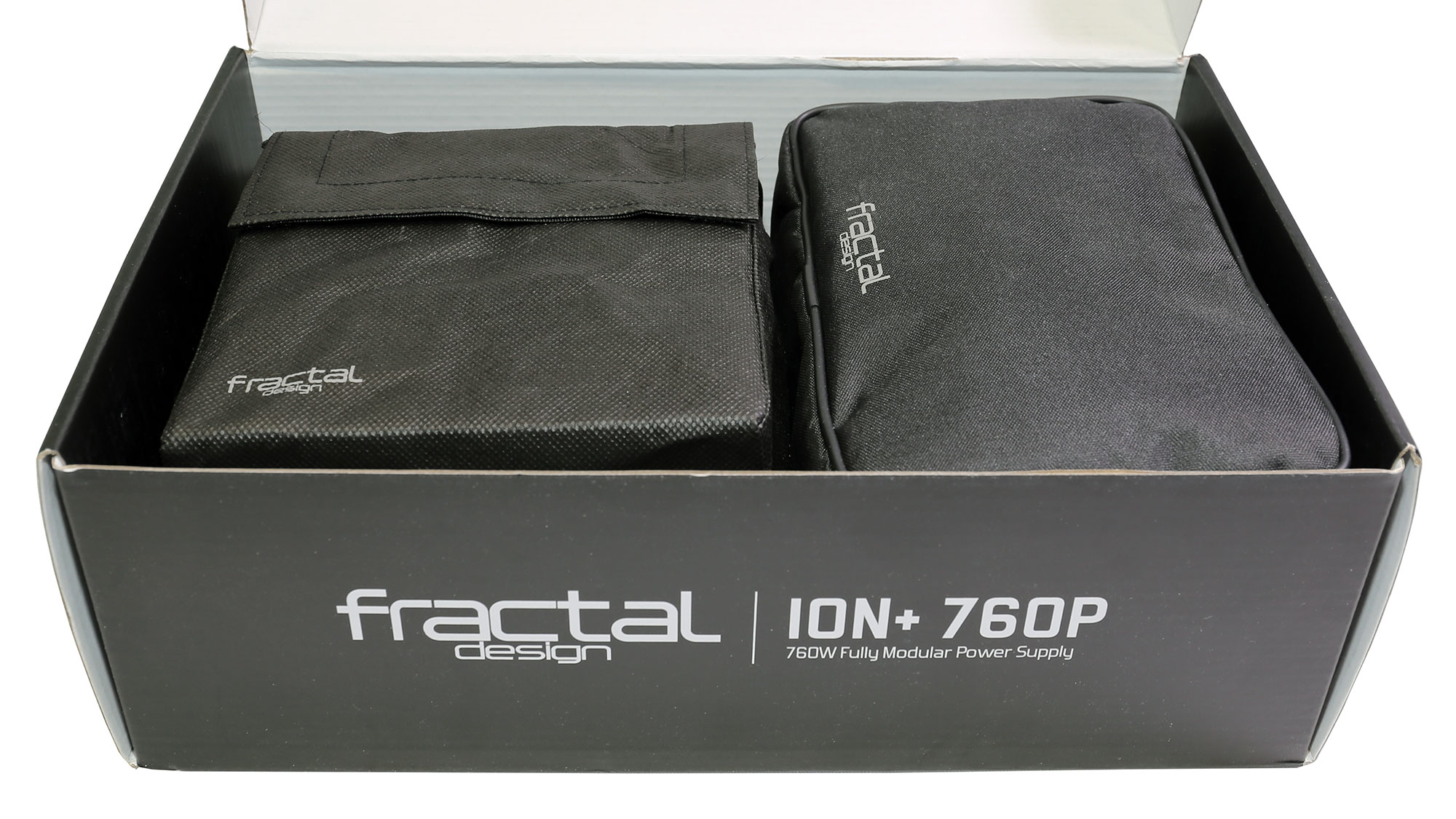



Specifications
| Test # | 12V | 5V | 3.3V | 5VSB | DC/AC (Watts) | Efficiency | Fan Speed (RPM) | PSU Noise (dB[A]) | Temps (In/Out) | PF/AC Volts |
| 1 | 4.490A | 1.991A | 1.993A | 1.002A | 76.156 | 88.142% | 0 | <6.0 | 45.81°C | 0.959 |
| 12.148V | 5.026V | 3.312V | 4.993V | 86.401 | 40.24°C | 115.12V | ||||
| 2 | 9.964A | 2.985A | 2.993A | 1.204A | 151.854 | 91.588% | 0 | <6.0 | 46.82°C | 0.984 |
| 12.139V | 5.024V | 3.308V | 4.986V | 165.802 | 40.62°C | 115.12V | ||||
| 3 | 15.807A | 3.486A | 3.479A | 1.406A | 227.752 | 92.725% | 0 | <6.0 | 47.74°C | 0.994 |
| 12.130V | 5.023V | 3.306V | 4.979V | 245.621 | 41.35°C | 115.11V | ||||
| 4 | 21.663A | 3.985A | 3.993A | 1.610A | 303.762 | 92.467% | 478 | 7.8 | 41.65°C | 0.996 |
| 12.120V | 5.022V | 3.304V | 4.970V | 328.507 | 48.52°C | 115.11V | ||||
| 5 | 27.230A | 4.946A | 5.000A | 1.815A | 379.887 | 92.200% | 489 | 8.1 | 42.30°C | 0.997 |
| 12.110V | 4.979V | 3.300V | 4.961V | 412.027 | 49.45°C | 115.11V | ||||
| 6 | 32.741A | 5.984A | 6.006A | 2.020A | 456.015 | 91.574% | 555 | 9.9 | 42.54°C | 0.998 |
| 12.101V | 5.016V | 3.296V | 4.953V | 497.976 | 50.27°C | 115.11V | ||||
| 7 | 38.255A | 6.985A | 7.018A | 2.226A | 531.742 | 91.064% | 600 | 11.9 | 43.36°C | 0.998 |
| 12.093V | 5.013V | 3.292V | 4.944V | 583.922 | 51.40°C | 115.11V | ||||
| 8 | 43.849A | 7.990A | 8.032A | 2.433A | 608.258 | 90.457% | 756 | 18.5 | 43.92°C | 0.998 |
| 12.083V | 5.009V | 3.287V | 4.935V | 672.427 | 52.90°C | 115.10V | ||||
| 9 | 49.777A | 8.491A | 8.523A | 2.433A | 683.585 | 89.878% | 933 | 25.3 | 44.15°C | 0.999 |
| 12.075V | 5.008V | 3.285V | 4.935V | 760.574 | 53.51°C | 115.10V | ||||
| 10 | 55.551A | 8.999A | 9.051A | 3.058A | 760.010 | 89.165% | 1046 | 29.0 | 45.08°C | 0.999 |
| 12.066V | 5.003V | 3.282V | 4.907V | 852.363 | 54.81°C | 115.10V | ||||
| 11 | 61.897A | 9.003A | 9.064A | 3.061A | 836.037 | 88.541% | 1336 | 36.2 | 46.52°C | 0.999 |
| 12.057V | 5.001V | 3.278V | 4.903V | 944.232 | 57.01°C | 115.10V | ||||
| CL1 | 0.154A | 14.003A | 14.000A | 0.000A | 118.180 | 84.237% | 0 | <6.0 | 49.53°C | 0.981 |
| 12.125V | 5.018V | 3.289V | 5.064V | 140.295 | 42.56°C | 115.12V | ||||
| CL2 | 63.354A | 1.004A | 1.001A | 1.000A | 778.434 | 89.727% | 1321 | 35.8 | 45.35°C | 0.999 |
| 12.077V | 5.014V | 3.296V | 4.974V | 867.558 | 54.46°C | 115.10V |
Power Specifications
| Rail | 3.3V | 5V | 12V | 5VSB | -12V | |
|---|---|---|---|---|---|---|
| Max. Power | Amps | 22 | 22 | 63.3 | 3 | 0.3 |
| Watts | 120 | 760 | 15 | 3.6 | ||
| Total Max. Power (W) | 760 |
Cables & Connectors
| Description | Cable Count | Connector Count (Total) | Gauge | In Cable Capacitors |
|---|---|---|---|---|
| ATX connector 20+4 pin (600mm) | 1 | 1 | 18AWG | No |
| 4+4 pin EPS12V (700mm) | 2 | 2 | 16AWG | No |
| 6+2 pin PCIe (550mm+120mm) | 3 | 6 | 16-18AWG | No |
| SATA (650mm+120mm) | 1 | 2 | 18AWG | No |
| SATA (400mm+120mm+120mm+120mm) | 2 | 8 | 18AWG | No |
| 4 pin Molex (400mm+120mm+120mm+120mm) | 1 | 4 | 18AWG | No |
| AC Power Cord (1400mm) - C13 coupler | 1 | 1 | 16AWG | - |
The strong advantage of the cables is that they are super flexible, so cable management and routing will be much easier compared to PSUs with stiff cables, that feature inline caps. Another advantage is that the cables are long, especially the EPS one. Moreover, there are two EPS connectors on dedicated cables, along with six PCIe, which are hosted on three cables. The only downside is the short distance between the peripheral connectors, which should be 150 mm, at least.









Cable Photos
Component Analysis
We strongly encourage you to have a look at our PSUs 101 article, which provides valuable information about PSUs and their operation, allowing you to better understand the components we're about to discuss.
| General Data | |
| Manufacturer (OEM) | High Power |
| PCB Type | Double Sided |
| Primary Side | |
| Transient Filter | 4x Y caps, 2x X caps, 3x CM chokes, 1x MOV,1x Discharge IC |
| Inrush Protection | NTC Thermistor & Relay |
| Bridge Rectifier(s) | 2x GBU1506 (600V, 15A @ 100°C) |
| APFC MOSFETs | 2x Infineon IPA60R120P7 (650V, 16A @ 100°C, 0.120Ohm) |
| APFC Boost Diode | 1x Infineon IDH08G65C5 (650V, 8A @ 145°C) |
| Hold-up Cap(s) | 2x Rubycon (400V, 470uF each or 940uF combined, 2,000h @ 105°C, MXH) |
| Main Switchers | 2x Infineon IPA60R120P7 (650V, 16A @ 100°C, 0.120Ohm) |
| APFC Controller | Infineon ICE3PCS01G |
| Resonant Controller | Champion CM6901X |
| Topology | Primary side: Half-Bridge & LLC converter Secondary side: Synchronous Rectification & DC-DC converters |
| Secondary Side | |
| +12V MOSFETs | 8x Infineon BSC027N04LS (40V, 88A @ 100°C, 2.7mOhm) |
| 5V & 3.3V | DC-DC Converters:8x Infineon BSC0906NS (30V, 40A @ 100°C, 4.5mOhm) PWM Controller: ANPEC APW7159C |
| Filtering Capacitors | Electrolytic: 4x Nippon Chemi-Con (4-10,000h @ 105°C, KY), 5x Rubycon (3-6,000h @ 105°C, YXG), 1x Rubycon (6-10,000h @ 105°C, ZLH) Polymer: 31x FPCAP, 6x NIC |
| Supervisor IC | SITI PS224 (OCP, OVP, UVP, SCP, PG) |
| Micro Controller | STC 15W408AS |
| Fan Model | Fractal Design DYNAMIC X2 GP-14 (140mm, 3-12V, 0.35A, 1700 rpm, Fluid Dynamic Bearing Fan ) |
| Fan Power Transistor | STi 2SD882 (NPN) |
| 5VSB Circuit | |
| Rectifier | 1x PFC P10V45SP SBR (45V, 10A) & 2x Infineon BSC0906NS FET (30V, 40A @ 100°C, 4.5mΩ) |
| Standby PWM Controller | Excelliance MOS Corp EM8569 |
| -12V Circuit | |
| Rectifier | KEC KIA7912PI (-12V, 1A) |

Overall Photos
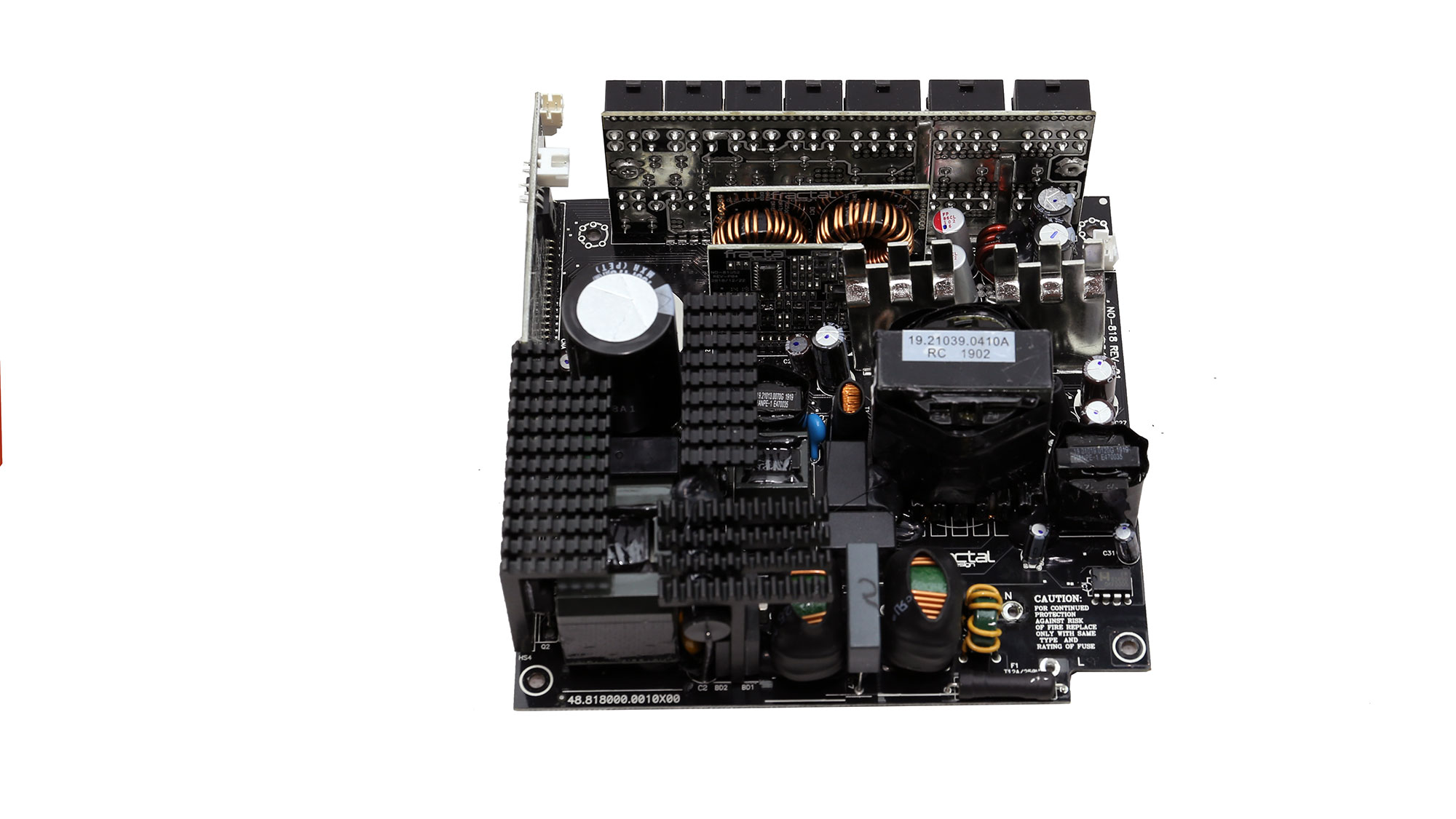


Fractal Design cooperated with High Power for the Ion+ Platinum PSU line. This is the same platform used in the Thermaltake Toughpower Grand RGB Gold line with some modifications which make it even better. For example, there is proper inrush current protection now, which means less stress for your home's electrical infrastructure.
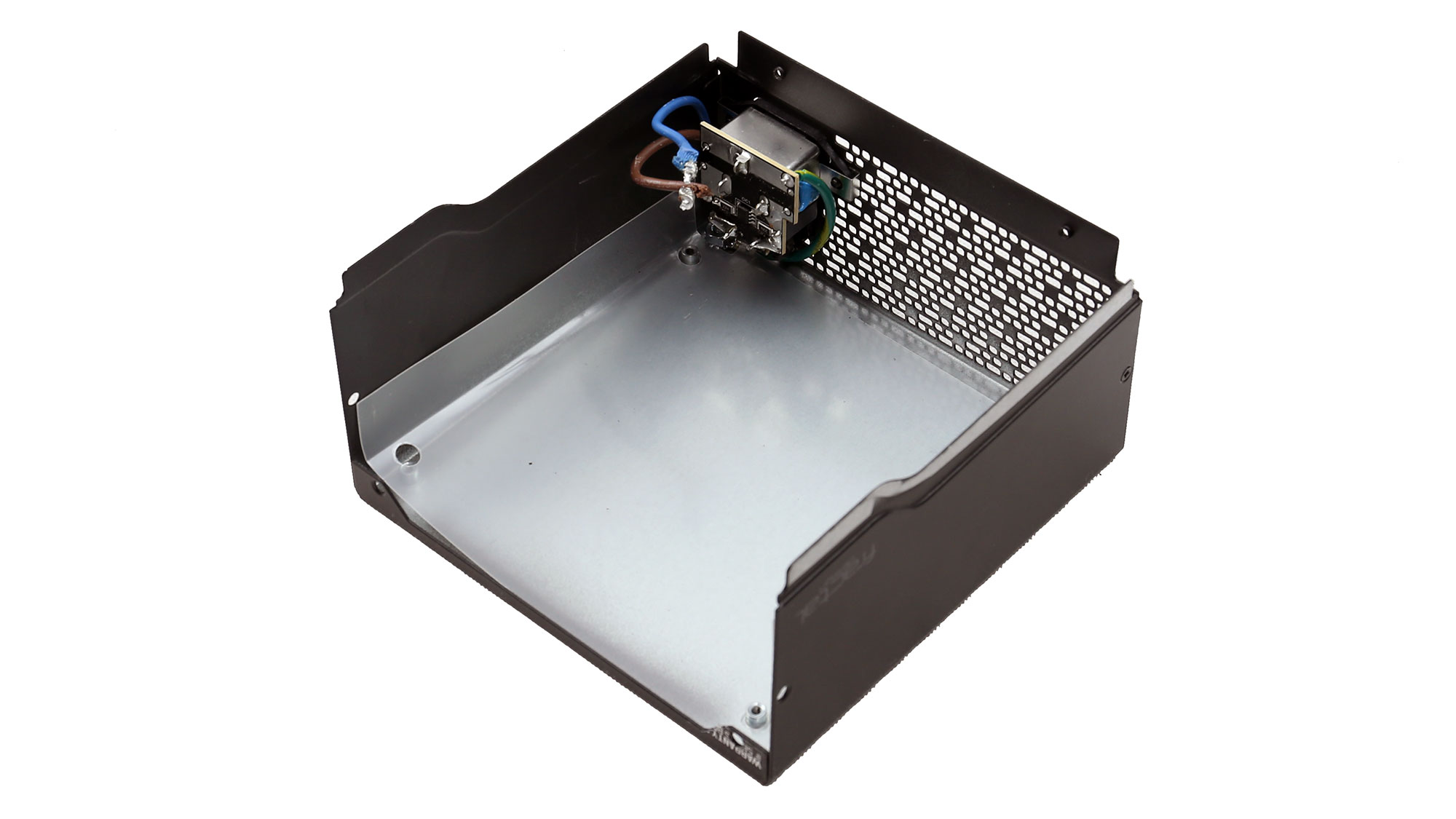
Transient filter





The transient filter has all the required components, but our EMC pre-compliance tests will show how effective they are because the design matters the most here.
Get Tom's Hardware's best news and in-depth reviews, straight to your inbox.
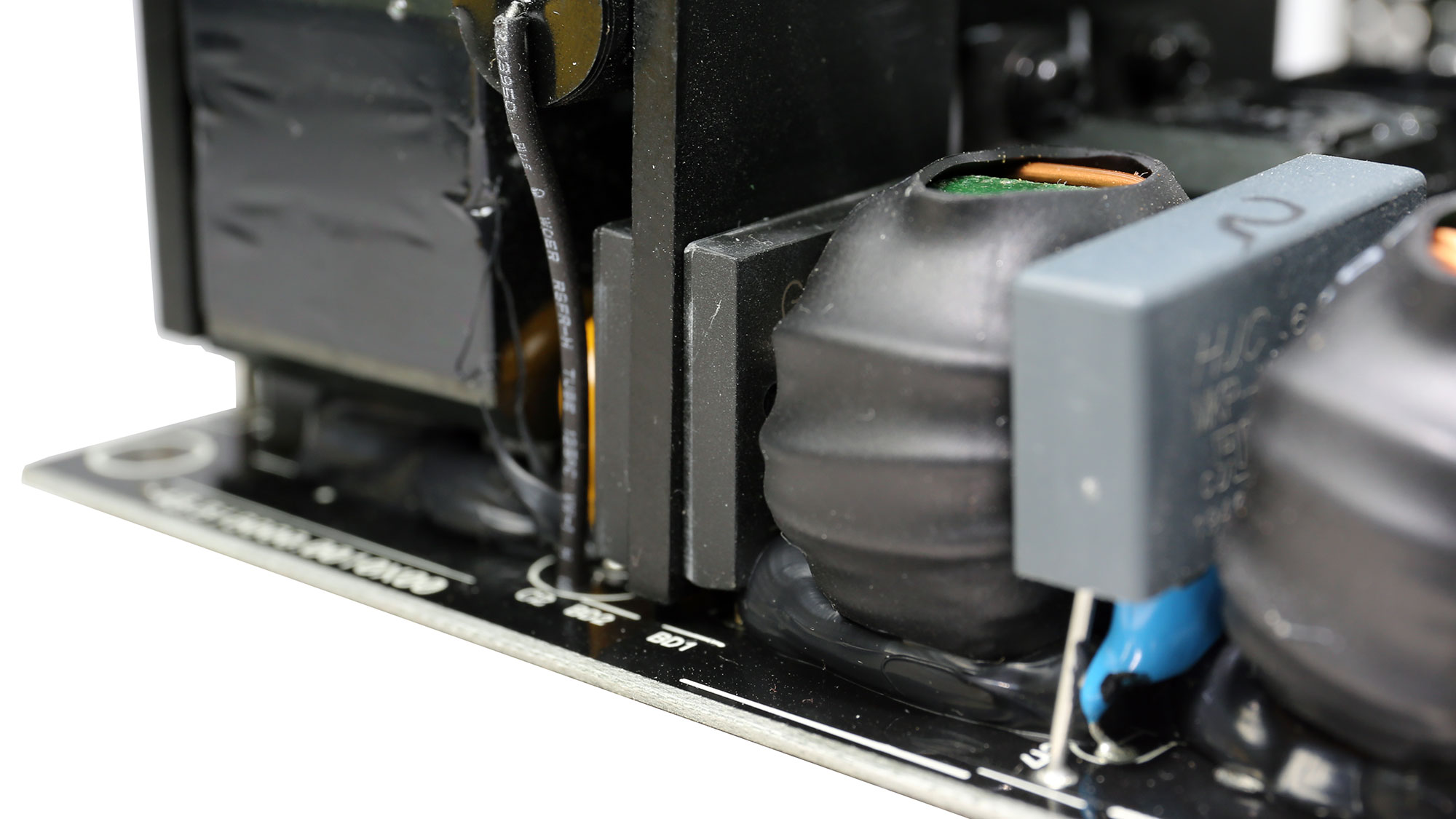
Bridge rectifiers
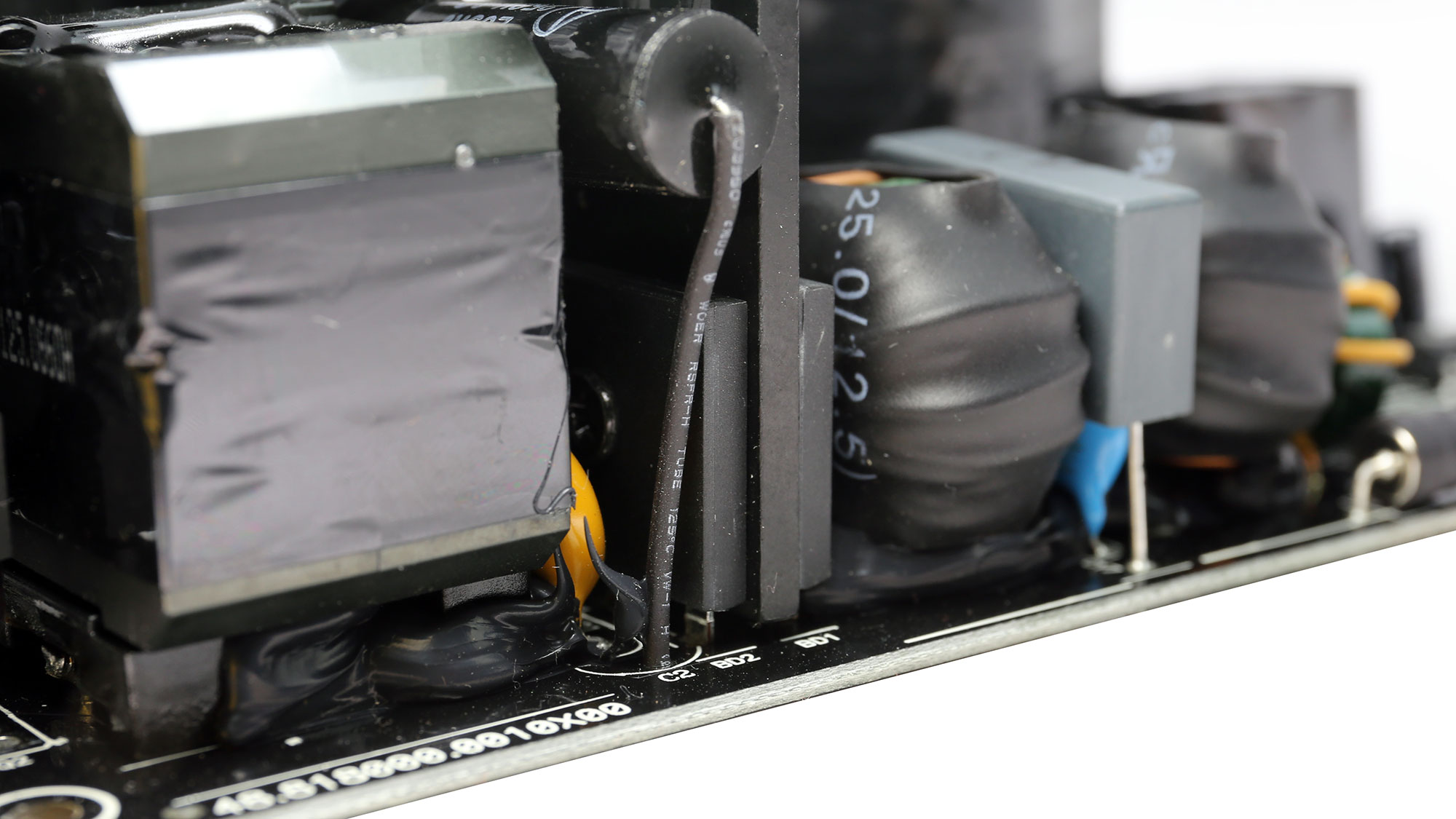
There are two powerful bridge rectifiers, able to handle up to 30A of current if required.

APFC converter



The APFC converter uses two Infineon FETs and a single boost diode, provided by the same manufacturer. The bulk caps are by Rubycon and have enough capacity, to provide a (much) longer than 17ms hold-up time.
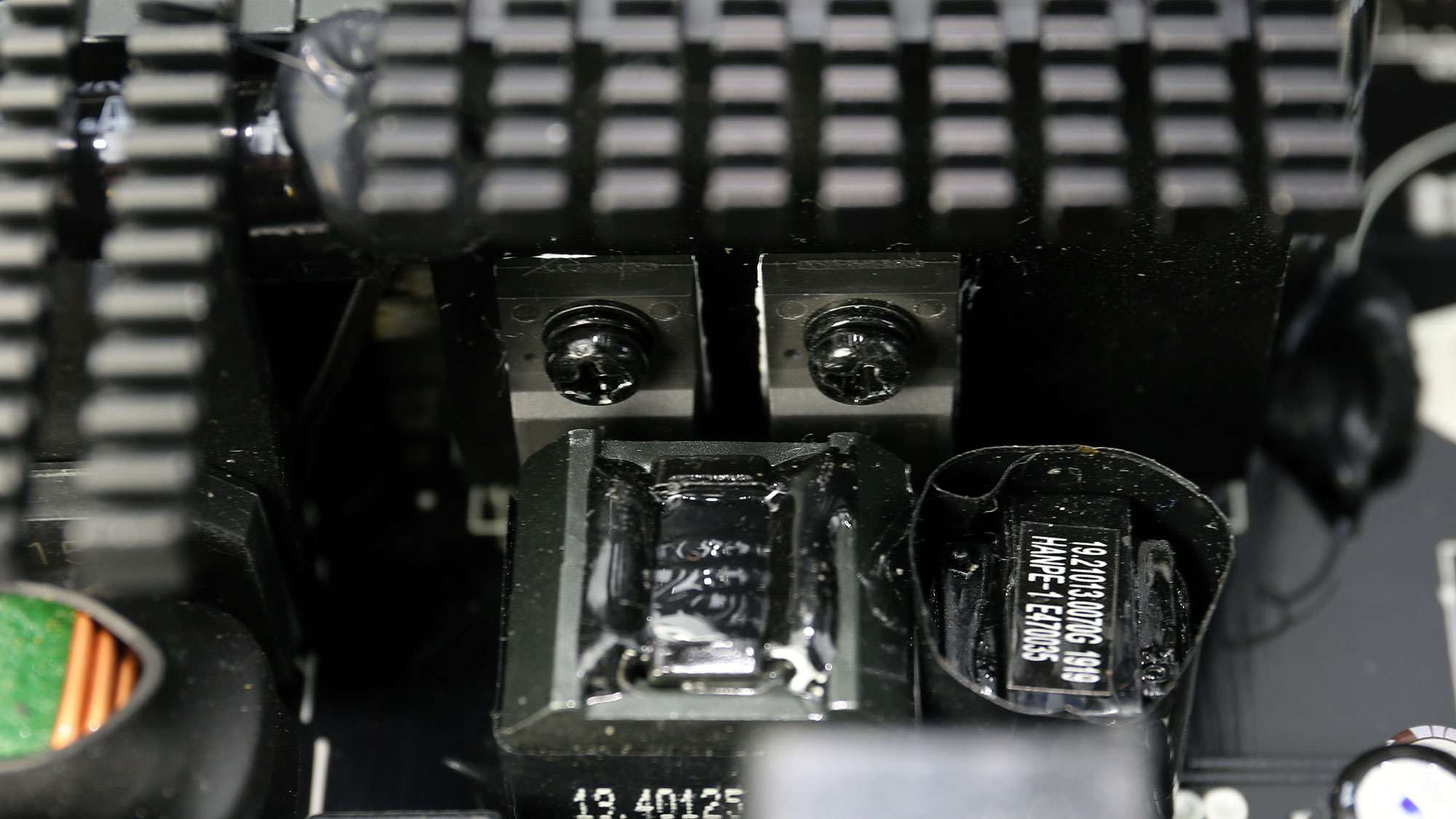
Main FETs and primary transformer


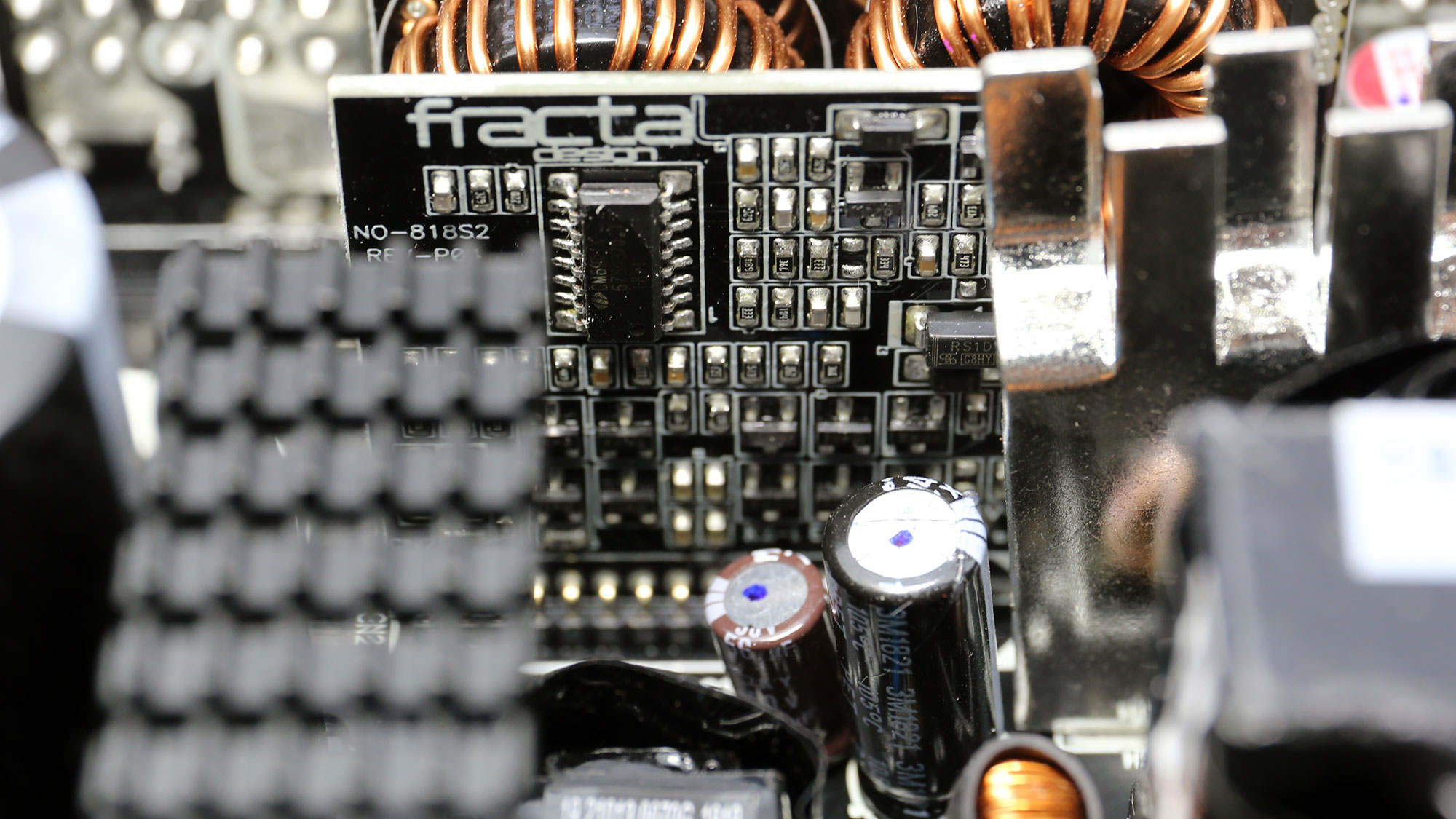
The main switching FETs are provided by Infineon, and they are installed in a half-bridge topology.

12V FETs and VRMs




The FETs that regulate the +12V rail are installed on the solder side of the PCB. Eight Infineon FETs are used, in total. Moreover, a pair of VRMs generates the minor rails.

Supervisor IC

A pretty large daughter-board hosts several interesting parts, including the supervisor IC, a SITI PS224, and an STC 15W408AS microcontroller.

5VSB & -12V Circuits



The 5VSB rail uses a pair of FETs and an SBR, on its secondary side and the standby PWM controller is an Excelliance MOS Corp EM8569.

Modular board front


Lots of polymer caps are installed on the face of the modular board.

Soldering quality




The soldering quality is impeccable. High Power did a very good job in this regard.

Cooling fan


Fractal Design used a high-quality FDB fan in this unit, with a low start-up voltage which allows it for minimal noise output at low RPM.
Current page: Specifications and Part Analysis
Next Page Load Regulation, Hold-Up Time, Inrush Current, Efficiency and Noise
Aris Mpitziopoulos is a contributing editor at Tom's Hardware, covering PSUs.
-
shadyj Reply
Hello,Admin said:The Ion+ 760P from Fractal Design offers good performance and silent operation at a decent price.
Fractal Design Ion+ Platinum 760W Power Supply Review : Read more
I just want to thank Tom's Hardware for such in-depth PSU reviews like this with serious measurements. I will admit most of the metrics in the review go over my head, but the reviewer does provide guidance as to how those measurements rank the product under review. I know this is not easy to do since I review products that have measurable performance that can get highly technical, but I try to provide commentary as to the meaning of the test results. These objective results are so much more valuable than some "influencer's" subjective experience on youtube or some other low data review. This really helps us who aren't electrical engineers make a slightly more informed purchase with more confidence.
Thanks! -
NoFaultius Interesting timing on your article. I just RMA'd this power supply today. It worked great for 10 months, then started causing random reboots. While it worked, it worked great. Silent and strong. So far, they have been good with the RMA process. They emailed me a label to send them the defective unit back. Apparently they will send me a replacement once they get it and run some tests.Reply